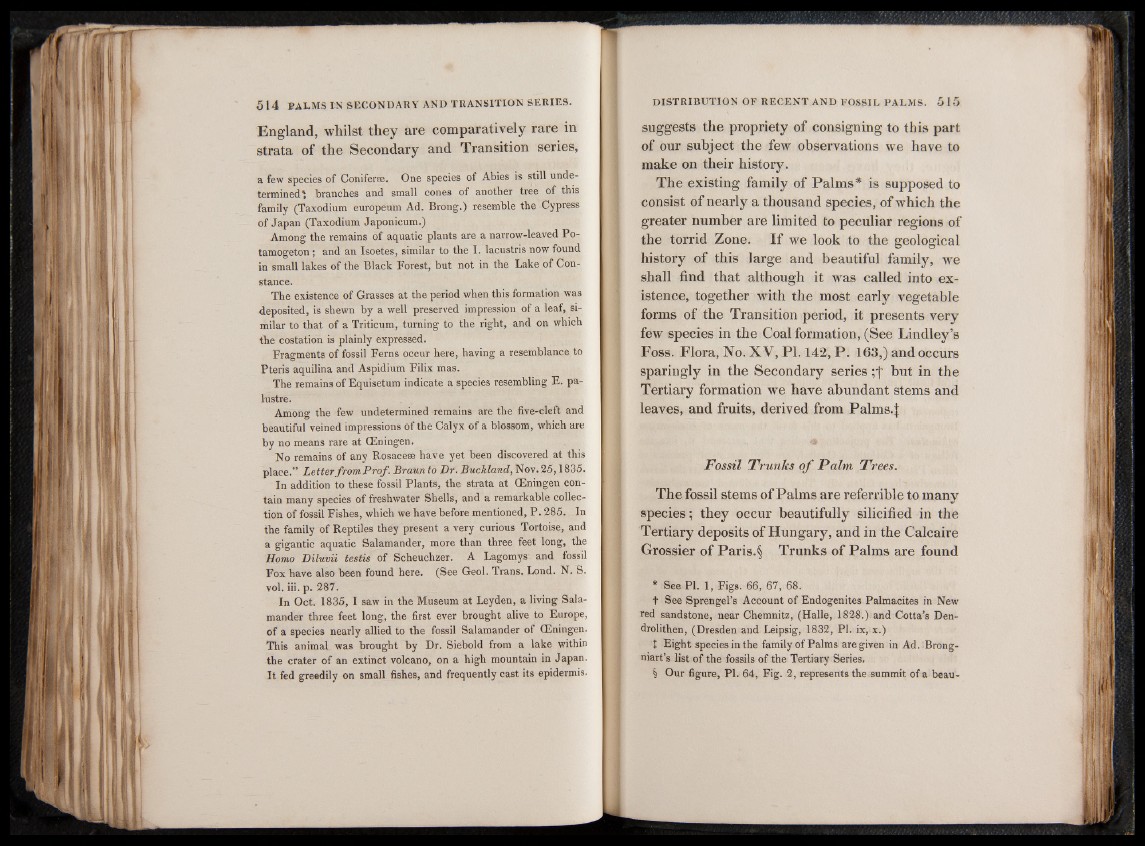
England, whilst they are comparatively rare in
strata of the Secondary and Transition series,
a few species of Coniferse. One species of Abies is still undetermined^
branches and small cones of another tree of this
family (Taxodium europeum Ad. Brong.) resemble the Cypress
of Japan (Taxodium Japonicum.)
Among the remains of aquatic plants are a narrow-leaved Po-
tamogeton; and an Isoetes, similar to the I. lacustris now found
in small lakes of the Black Forest, but not in the Lake of Constance.
The existence of Grasses at the period when this formation was
deposited, is shewn by a well preserved impression of a leaf, similar
to that of a Triticum, turning to the right, and on which
the costation is plainly expressed.
Fragments of fossil Ferns occur here, having a resemblance to
Pteris aquilina and Aspidium Filix mas.
The remains of Equisetum indicate a species resembling E. pa-
lustre.
Among the few undetermined remains are the five-cleft and
beautiful veined impressions of the Calyx of a blossom, which are
by no means rare at (Eningen.
No remains of any Rosacese have yet been discovered at this
place.” Letter from Prof. Braun to Dr. Buckland, Nov. 25,1835.
In addition to these fossil Plants, the strata at (Eningen contain
many species of freshwater Shells, and a remarkable collection
of fossil Fishes, which we have before mentioned, P. 285. In
the family of Reptiles they present a very curious Tortoise, and
a gigantic aquatic Salamander, more than three feet long, the
Homo Diluvii testis of Scheuchzer. A Lagomys and fossil
Fox have also been found here. (See Geol. Trans. Lond. N. S.
vol. iii. p. 287.
In Oct. 1835, I saw in the Museum at Leyden, a living Salamander
three feet long, the first ever brought alive to Europe,
of a species nearly allied to the fossil Salamander of (Eningen.
This animal was brought by Dr. Siebold from a lake within
the crater of an extinct volcano, on a high mountain in Japan.
It fed greedily on small fishes, and frequently cast its epidermis.
suggests the propriety of consigning to this part
of our subject the few observations we have to
make on their history.
The existing family of Palms* is supposed to
consist of nearly a thousand species, of which the
greater number are limited to peculiar regions of
the torrid Zone. I f we look to the geological
history of this large and beautiful family, we
shall find that although it was called into existence,
together with the most early vegetable
forms of the Transition period, it presents very
few species in the Coal formation, (See Lindley’s
Foss. Flora, No. XV, PI. 142, P. 163,) and occurs
sparingly in the Secondary series af but in the
Tertiary formation we have abundant stems and
leaves, and fruits, derived from Palms.J
Fossil Trunks of Palm Trees.
The fossil stems of Palms are referrible to many
species; they occur beautifully silicified in the
Tertiary deposits of Hungary, and in the Calcaire
Grossier of Parish Trunks of Palms are found
* See PI. 1, Figs. 66, 67, 68.
t See Sprengel’s Account of Endogenites Palmacites in New
red sandstone, near Chemnitz, (Halle, 1828.) and Cotta’s Den-
drolithen, (Dresden and Leipsig, 1832, PI. ix, x.)
t Eight species in the family of Palms are given in Ad. Brong-
niart’s list of the fossils of the Tertiary Series.
I Our figure, PI. 64, Fig. 2, represents the summit of a beau